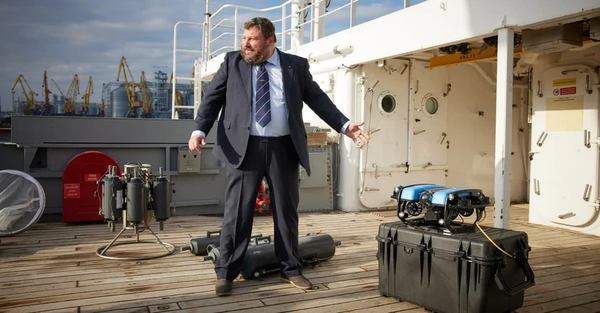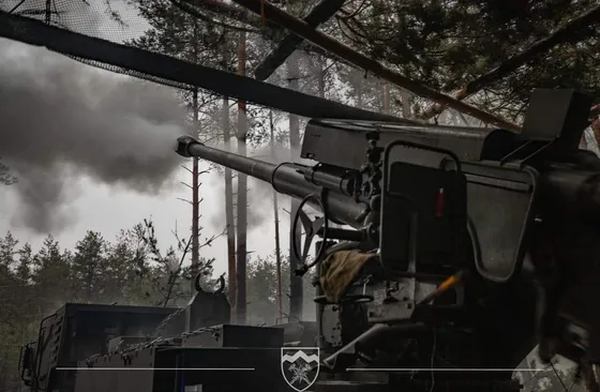Для многих украинцев результат контрнаступления 2023-го стал неутешительным, то ли из-за его чрезмерной разрекламированности в течение всего года, что повлияло на завышенные ожидания, то ли из-за усталости от войны.
Но в любом случае война Украины против России продолжается. В 2024 году главнокомандующий ВСУ Валерий Залужный констатировал фактический переход к позиционной войне. Однако проблемами для армии остаются снарядный голод, неопределенность с мобилизацией, замороженная помощь от США. Как эти проблемы влияют на фронт и что с ними делать, журналисты издания «The Page» узнавали у Евгения Дикого, военного обозревателя и бывшего командира роты батальона «Айдар».

Как снарядный голод влияет на ситуацию на фронте
Можете ли вы объяснить, как нехватка снарядов непосредственно влияет на ситуацию на фронте?
Сейчас у нас расход снарядов в день — примерно две тысячи. Это на самом деле страшный снарядный голод.
Еще два-три месяца назад, до снарядного голода, достаточно было выявить координаты цели и вовремя передать их артиллерии. Сейчас совершенно другая картина: собираются данные по различным целям и офицеры садятся и решают: «На это мы снаряды тратим, а это еще пусть погуляет». Это на самом деле каждый раз очень болезненный выбор.
Более того, на некоторых участках фронта лучшую западную арту мы сейчас просто отводим. Потому что нет смысла ее держать как приманку для «ланцетов» (российских дронов) в ситуации, когда они за день сделают, возможно, несколько выстрелов.

Собственно, Европа дает, что может. Франция дает три тысячи снарядов в месяц. И это она втрое увеличила свое производство уже за год. А почему так? Потому что годовая норма армии Франции была семь тысяч снарядов. Мы же на пике нашего летнего наступления тратили семь-восемь тысяч в день.
Европейская «бонсай-армия» не готова к войне
Можем ли мы изготавливать больше снарядов в Украине и где бы мы могли их брать еще?
Да, мы можем производить в Украине гораздо больше снарядов, но не сразу. Многие думают, что вся проблема в деньгах, но, к сожалению, мирового военторга, о котором во время аннексии Крыма говорил Путин, не существует.
Например, почти год назад Евросоюз пообещал в течение года поставить нам миллион снарядов. К марту этого года, возможно, они выйдут на 600 тысяч. Все предприятия ЕС не смогли за год столько сделать, при том, что заказ уже законтрактован.
Когда 30 лет вся Европа разбирала, демонтировала, перепрофилировала на совершенно другую продукцию эти предприятия, то теперь не просто надо расконсервировать старые заводы, у большинства их просто нет.
Яркий пример ракеты «Стингер». Нам их дали большое количество, и в результате американская армия попросила восстановить собственные запасы. Так вот, им пришлось находить дедушек на пенсии, которые когда-то в 80-е делали эти «Стингеры», просить их вернуться на работу, научить молодых. То есть когда 30 лет приходила в упадок целая отрасль, то, к сожалению, это не решается просто деньгами. Это решается деньгами, временем и большими усилиями.
Когда европейцы смогут выйти на адекватное количество снарядов в месяц для ВСУ?
Европейцы надеются выйти на более-менее нормальные объемы снарядного производства где-то через три года. В лучшем случае.
Жозеф Борель, главный дипломат ЕС, еще год назад сказал, что Европа вырастила «бонсай-армии». Вот это, пожалуй, самое точное определение, то есть оно хорошо выглядит, но оно полметра и все.
А в Украине все, что сейчас производится, прямо с конвейера идет на фронт. Оказывается, что уже только наша оборонка делает гораздо больше, чем та же Франция. Но это все равно несравнимо меньше, чем нужно.
Могут ли дроны заменить артиллерию на фронте
Могут ли дроны быть альтернативой артиллерии или даже заменить ее, как об этом можно услышать?
Никоим образом нет. Это так же, как автомат Калашникова не является альтернативой артиллерии. У каждого оружия есть своя ниша, которую оно закрывает.
Особенно это часто говорят, что альтернативой артиллерии являются FPV-шки. Никоим образом нет. Начнем с радиуса действия: FPV — обычно 7-8 км. Арта обычно работает на 40 км, а РСЗО — на 70 км.
Даже при условии снарядного голода и крайне удачной работы наших дронщиков более 80% поражения личного состава — арта. Хотя уже более половины уничтоженной техники — дроны.
Почему переход к обороне — это нежелательный вариант войны для Украины
Насколько вынужденный из-за снарядного голода переход к обороне является хорошим вариантом для ВСУ?
Это как раз полностью решает Конгресс США. Вот здесь у нас есть два совершенно разных сценария. Если нам возобновят поставки БК хотя бы с апреля, нам ни в коем случае не стоит становиться в оборону. Нам надо наоборот идти дальше, наступать и максимально уничтожать орду.
А почему, если, скажем, для уничтожения врага эффективнее стоять в обороне?
Это действительно эффективнее, вы правы. Но как надолго? Думайте не об одном дне, думайте о немножко дольше. Если мы становимся в глухую оборону, то мы даем тем же оркам спокойненько провести еще несколько волн мобилизации.
За это время их оборонка наштампует снарядов и танков. Их оборонка сейчас делает 20 новых машин в месяц и где-то 50 они способны расконсервировать. То есть в целом на фронт приезжает 70 машин. А мы за это время сжигаем, по данным независимых наблюдателей, от 100 до 150 танков, в среднем 120. То есть вот 70 приехало, 120 сгорело. Эта разница 50 танков, она ежемесячно накапливается.
А теперь представьте, что вместо этого наоборот накапливается каждый месяц плюс 70 новых танков, которые где-то себе стоят и ждут. То есть к концу года имеем плюс 800 машин.
Нам категорически невыгодно давать им паузу. И если помните, с их стороны было очень много сигналов: а давайте заморозим. Так вы же понимаете, что они не просто так эти сигналы давали.
Готовы ли мы к плохому сценарию с помощью от США и полному переходу к обороне? Готовы ли наши линии фортификаций?
На самом деле это можно было начать еще в 2015 году. У нас было восемь лет на то, чтобы спокойно подготовить укрепления везде. И тогда вообще начало даже этой войны выглядело бы принципиально иначе.
Но такое впечатление, что нам пришлось своими лбами побиться о линию Суровикина, чтобы до наших военачальников дошло, что нам надо окапываться.
Лучше поздно, чем никогда: вот под конец 23-го года наконец пошли команды копать. Сейчас эти линии еще абсолютно не готовы.
Что делать Украине, если помощи от США больше не будет
Сейчас $61 млрд для Украины заблокирован из-за споров республиканцев и демократов по границе. Что мы можем сделать, если эту помощь так и не предоставят, скажем, до ноября, выборов президента США?
Очень печальный для нас вариант. Во-первых, тогда точно переходим в оборону, чего ни в коем случае не делаем, в случае если БК снова пойдет.
Далее, делаем секвестр бюджета, то есть срезаем деньги со всего, с чего можно, ищем, а поверьте, очень много еще есть где. Забираем все, что сейчас идет на плиточки, фонтанчики, мостики и так далее. Создаем единый Оборонный фонд. Поднимаем на несколько процентов военный налог, акцизы, то есть компенсируем хотя бы финансовое измерение. Далее даем команду нашим спецслужбам по всем странам третьего мира искать все, даже очень нелегальные схемы закупки и поставки. Вот, и тем временем вливаем, вливаем, вливаем в нашу оборонную отрасль.
Более того, не просто покупаем у производителей готовую продукцию, а государство спрашивает их проблемы с технологиями, оборудованием, поставками и пытается решить их, а на замену требует точных результатов.
Как решить вопрос мобилизации в Украине
Прежде всего почему нам нужно мобилизовать именно 500 тысяч человек?
На самом деле здесь не надо быть Залужным и иметь доступ к генштабовским материалам, достаточно просто посмотреть, сколько мобилизуют орки. А дальше понять, что технологически мы с ними на одном уровне.
Конечно, можно воевать значительно меньшими силами, чем враг, если его буквально космически превосходить в технологиях. Но ведь ясно, что у нас с орками это не так, мы в одной весовой категории.
Как можно улучшить нынешние условия мобилизации?
Рекрутинг — он особенно вспомогательный в условиях массовой мобилизации, потому что дает выбор.
Возможность выбрать специализацию — убирает страх неизвестности относительно того, что ты будешь делать в армии.
Учет гражданских навыков — позволяет подобрать позицию по возможностям.
В чем главные проблемы второго варианта обновленного Закона о мобилизации?
Второй вариант законопроекта о мобилизации будто создан, чтобы никоим образом не раздражать уклонистов.
Сейчас человек стоит перед очень неправильным выбором: или выполнить свой конституционный долг, надеть пиксель и, возможно, не вернуться, потому что предельного срока службы не существует, или заплатить 1700 грн штрафа.
По моему мнению, новый законопроект должен четко сказать: друг, ты сейчас должен отдать государству 36 месяцев своей жизни. И у тебя есть выбор: 36 месяцев в пикселе с хорошей оплатой, с уважением от общества и возвращаешься героем, или эти ровно 36 месяцев сидишь на зоне. Вот этот выбор сделать гораздо проще.
Важно, что законопроект наконец предлагает предельный срок службы 36 месяцев вместо нынешней ситуации «билета в один конец». Но люди, которые это прописали, до сих пор считают, что 36 месяцев во Львовском ТЦК и 36 месяцев в Авдеевке — это одинаковые три года службы. На самом деле эта норма законопроекта может быть сделана правильной, с помощью всего одной строки, что день на нуле считается за три.
Только преодолев эти две главные проблемы — предельный срок службы и наказание за уклонение от воинского учета, — можно построить нормальную мобилизацию.


